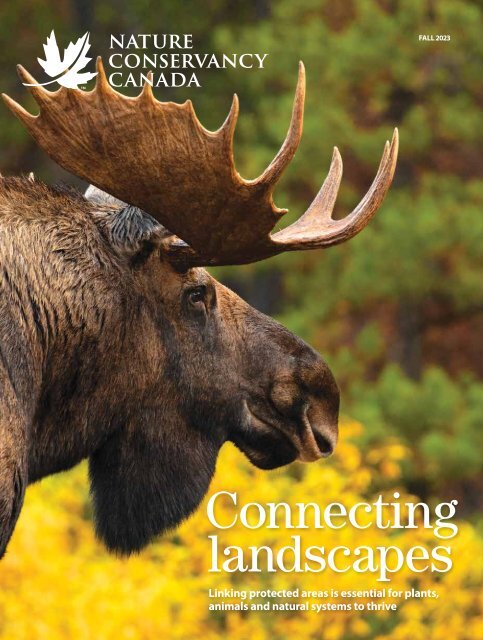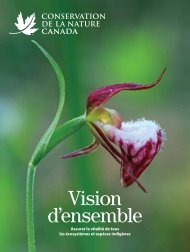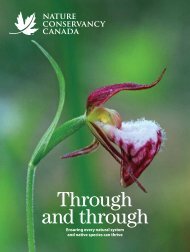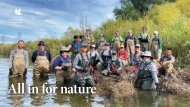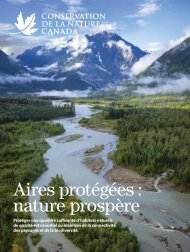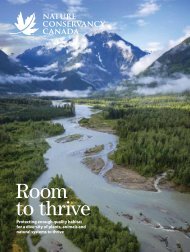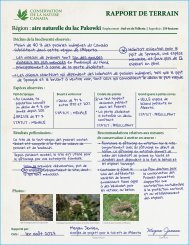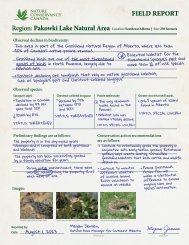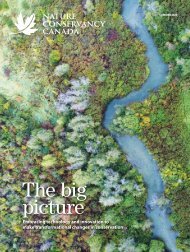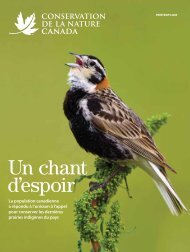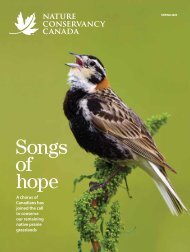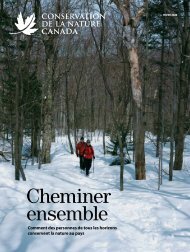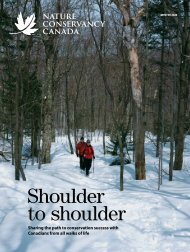NCC Magazine, Fall 2023
You also want an ePaper? Increase the reach of your titles
YUMPU automatically turns print PDFs into web optimized ePapers that Google loves.
FALL <strong>2023</strong><br />
TKTKTKTKTKTKT<br />
natureconservancy.ca<br />
Connecting<br />
landscapes<br />
Linking protected areas is essential for plants,<br />
animals and natural systems to thrive<br />
WINTER 2021 1
FALL <strong>2023</strong><br />
CONTENTS<br />
Nature Conservancy of Canada<br />
4 People power<br />
Fuelling restoration from coast to coast.<br />
6 Lac Frye Nature Reserve<br />
This Important Bird Area in New<br />
Brunswick is a feast for a bird lover’s eyes.<br />
7 Less can be more<br />
Small actions, like restoration in your<br />
garden, can increase our resilience<br />
in the face of climate change and<br />
biodiversity loss.<br />
7 Backpack essentials<br />
The Yukon’s landscapes provide<br />
endless photographic opportunities<br />
for 16-year-old Evan Howells.<br />
8 Making connections<br />
Read about the first of four CARE<br />
principles — connected — and<br />
how it’s creating meaningful<br />
conservation outcomes.<br />
12 Spotted wintergreen<br />
This threatened species is found in<br />
only one place in Canada.<br />
14 Future-proofing<br />
conservation<br />
Meet the next generation of applied<br />
conservation scientists.<br />
16 Project updates<br />
Huge win for grasslands in BC; an island<br />
paradise in Ontario; restoring natural and<br />
cultural connections in Quebec.<br />
18 At home on the water<br />
Whether in Iran or Canada, there’s<br />
no place like home.<br />
Digital extras<br />
Check out our online magazine page with<br />
additional content to supplement this issue,<br />
at nccmagazine.ca.<br />
Nature Conservancy of Canada<br />
365 Bloor Street East, Suite 1501<br />
Toronto, Ontario, Canada M4W 3L4<br />
magazine@natureconservancy.ca | Phone: 416.932.3202 | Toll-free: 877.231.3552<br />
The Nature Conservancy of Canada (<strong>NCC</strong>) is the country’s unifying force for nature. We seek<br />
solutions to the twin crises of rapid biodiversity loss and climate change through large-scale,<br />
permanent land conservation. <strong>NCC</strong> is a registered charity. With nature, we build a thriving world.<br />
The Nature Conservancy of Canada <strong>Magazine</strong> is distributed to donors and supporters of <strong>NCC</strong>.<br />
TM<br />
Trademarks owned by the Nature Conservancy of Canada.<br />
FSC® is not responsible for any calculations<br />
on saving resources by choosing this paper.<br />
Printed in Canada with vegetable-based inks by Warrens Waterless Printing.<br />
This publication saved 28 trees and 25,920 litres of water*.<br />
CREATED BY: CALCULATEUR.ROLLANDINC.COM. PHOTO: GUILLAUME SIMONEAU (KENAUK, QC). COVER: MARK RAYCROFT.<br />
*<br />
2 FALL <strong>2023</strong> natureconservancy.ca
Featured<br />
Contributors<br />
ETIENNE BOISVERT.<br />
Dear friends,<br />
I<br />
have been amazed by nature since my childhood, wanting to<br />
protect all the wonders it has to offer. With the climate crisis<br />
and the decline of species, I care even more about taking action<br />
to increase its resiliency.<br />
It’s perhaps no surprise that at the Nature Conservancy of Canada<br />
(<strong>NCC</strong>), we CARE about nature every day. You see, for nature to<br />
thrive, protected and conserved areas need to be Connected, have<br />
Adequate quality habitats, be Representative of all species and be<br />
managed Effectively. Together, those principles represent an internationally<br />
recognized framework to support resilient landscapes. If<br />
the places we conserve meet these criteria, landscapes will be able<br />
to withstand the impacts of climate change and biodiversity loss. And<br />
if they are resilient, then we feel confident we are building a thriving<br />
world with nature.<br />
In fact, CARE has become such an important lens for our work<br />
here at <strong>NCC</strong>, that we’re going to feature it over the next four issues<br />
of the <strong>NCC</strong> magazine.<br />
In this issue, we start the series off with the C in CARE: connected.<br />
As Dominique Ritter explains in her feature story, connectivity is<br />
important in all aspects of our work. It can mean a small passage to<br />
allow frogs to cross a road safely, or a large wilderness corridor for<br />
wide-ranging mammals to move within. Connected landscapes can<br />
ensure that when faced with severe weather events or the threat of<br />
invasive species, plants and animals can continue to thrive throughout<br />
their range. Connected landscapes can also be places where<br />
people spend time in and care for nature.<br />
Connecting landscapes and being connected to landscapes is vital.<br />
Thank you for the care you show in supporting Canada’s nature.<br />
Yours in nature,<br />
Marie-Michele Rousseau-Clair<br />
Marie-Michele Rousseau-Clair<br />
Chief conservation officer<br />
Dominique Ritter<br />
is a writer and editor<br />
based in Quebec’s<br />
Laurentians. She’s the<br />
former editor-in-chief<br />
of Reader’s Digest<br />
and several custom<br />
magazines for Bookmark,<br />
and has also<br />
worked at The Canadian<br />
Encyclopedia and<br />
Adbusters. She wrote<br />
“Making connections,”<br />
page 8.<br />
Chanelle Nibbelink<br />
is a Canadian-American<br />
illustrator who<br />
enjoys applying<br />
conceptual thinking<br />
and stylistic exploration<br />
to all of her<br />
editorial, publishing<br />
and advertising<br />
projects. She<br />
illustrated “At home<br />
on the water,” page<br />
18, and “Less can be<br />
more,” page 7.<br />
natureconservancy.ca<br />
FALL <strong>2023</strong> 3
COAST TO<br />
COAST<br />
Conservation<br />
Volunteer removing<br />
encroaching shrubs<br />
to restore species at<br />
risk habitat, Ethier<br />
Sandhills, MB.<br />
50 per cent of the<br />
encroaching juniper<br />
has been removed.<br />
People<br />
power<br />
Conservation Volunteers are fuelling<br />
restoration efforts coast to coast<br />
Once the Nature Conservancy of Canada<br />
(<strong>NCC</strong>) conserves a natural area,<br />
there may be areas that need some<br />
CARE to return them to a connected, adequate,<br />
representative and effective ecosystem. Restoration<br />
activities, like planting native plants and<br />
removing invasive ones, cleaning up debris and<br />
rehabilitating altered natural features, can help<br />
ensure the landscapes under our care are thriving<br />
and resilient. This work can take years of<br />
effort and a lot of elbow grease.<br />
One pair of hands can only do so much, but<br />
as the saying goes, many hands make light<br />
work. Each year, our Conservation Volunteers<br />
play a vital role in restoring diverse ecosystems<br />
across Canada.<br />
The impact of our Conservation Volunteers<br />
is a testament to the power of collective action.<br />
Not only do they help <strong>NCC</strong> staff accomplish<br />
the work we simply couldn’t do alone, but our<br />
volunteers also inspire and empower communities<br />
to forge a deeper connection with nature.<br />
Thank you to all our Conservation Volunteers<br />
for their invaluable support in creating a thriving<br />
world with nature.<br />
READ MORE ABOUT OUR<br />
CONSERVATION VOLUNTEERS<br />
AND THEIR SUCCESSES ONLINE:<br />
CONSERVATIONVOLUNTEERS.CA<br />
LIL CREEK PHOTO & VIDEO.<br />
4 FALL <strong>2023</strong> natureconservancy.ca
ALBERTA<br />
Adopt a patch<br />
If you’ve ever spent time trying to rid your garden of weeds, you know<br />
that it takes hard work and perseverance. Now imagine trying to weed<br />
a property 100 times that size! That’s not a single-handed job. And<br />
that’s why Conservation Volunteers at Golden Ranches Conservation<br />
Area are helping remove and control invasive plants that are growing<br />
among the 110,000 native trees and shrub seedlings that were planted<br />
by Project Forest as part of a multi-year restoration project. Volunteers<br />
have been trained and assigned patches to adopt and weed repeatedly<br />
over the summer. Over time, their efforts will prevent these unwanted<br />
weeds from reproducing and allow native plants to thrive. To learn<br />
more, visit natureconservancy.ca/adopt-a-patch.<br />
8,867<br />
SQUARE<br />
METRES<br />
of weed patches targeted<br />
to prevent them from<br />
becoming larger and<br />
more difficult to control.<br />
3,000<br />
SEEDLINGS<br />
including white spruce, jack<br />
pine, white birch, red-osier<br />
dogwood and chokecherry<br />
have been planted since 2017.<br />
SASKATCHEWAN<br />
Giving nature some TLC<br />
Located 90 minutes north of Saskatoon, Meeting Lake 03 features close to<br />
200 hectares of woodlands, wetlands and grasslands. Parts of this area are threatened<br />
by habitat fragmentation, wetland loss and the removal of plants. That’s why<br />
Conservation Volunteers joined forces to plant 400 white spruces as part of an<br />
ongoing restoration project, which aims to bring this project back to its full glory.<br />
TOP TO BOTTOM: <strong>NCC</strong>; <strong>NCC</strong>; ANDREA MOREAU/<strong>NCC</strong> STAFF; <strong>NCC</strong>.<br />
MANITOBA<br />
Students<br />
safeguard<br />
the sandhills<br />
Not only is Ethier Sandhills,<br />
located 88 kilometres<br />
southwest of Brandon,<br />
home to a number of<br />
native plants, but it also<br />
provides important<br />
habitat for Manitoba’s only<br />
lizard: prairie skink. And<br />
a team of student volunteers<br />
from Assiniboine<br />
Community College’s Land<br />
and Water Management<br />
program have been<br />
lending a hand to ensure<br />
the landscape there<br />
provides healthy habitat<br />
for these species. In the<br />
last two years alone, the<br />
team cleared significant<br />
areas of encroaching<br />
aspen stands and juniper<br />
shrubs, ensuring native<br />
plants and species have<br />
room to thrive. More work<br />
is planned for this fall, and<br />
<strong>NCC</strong> and the students are<br />
excited to continue these<br />
restoration efforts.<br />
ONTARIO<br />
Bend it like Willow Creek<br />
Willow Creek flows slowly through the Minesing Wetlands, one of <strong>NCC</strong>’s largest and least disturbed<br />
wetlands in southern Ontario. But it wasn’t always this way. Historical dredging of the wetlands for<br />
agricultural purposes led to an overload of sediment, reducing the channel’s ability to absorb and<br />
filter water. It also degraded habitat for the species that relied on the creek and its beds. The Nottawasaga<br />
Valley Conservation Authority and <strong>NCC</strong> have teamed up with volunteers to recreate the<br />
stream’s natural meander, by submerging coniferous trees in the creek along the banks. Post-restoration<br />
monitoring indicates that the aquatic bug community is more diverse (more bug groups).<br />
QUEBEC<br />
Rooting for<br />
turtles<br />
Turtles can be very picky during<br />
nesting season. At the Parc des<br />
Rapides-du-Cheval-Blanc in the<br />
west end of Montreal, buckthorn<br />
was invading a regularly used<br />
turtle nesting site. Conservation<br />
Volunteers removed the invasive<br />
species to protect this natural<br />
area, conducted nesting surveys<br />
and submitted sightings to local<br />
turtle monitoring project:<br />
carapace.ca.<br />
250<br />
SQUARE METRES<br />
are now turtle friendly.<br />
NOVA SCOTIA<br />
Youth for Boar’s Head<br />
One of the many benefits of being a Conservation<br />
Volunteer is that each event is a learning experience.<br />
And while at the Boar’s Head Nature Reserve<br />
shoreline cleanup, on the west coast of the island<br />
and surrounded on every side by the Bay of Fundy,<br />
volunteers literally participated in a community-based<br />
learning program. For the second year in<br />
a row, a group of Grade 10 students from Islands<br />
Consolidated School, along with local community<br />
members, joined forces at the event. Volunteers<br />
removed 19 extra-large garbage bags worth of<br />
debris from a 500-metre stretch of shoreline. To learn<br />
more, visit natureconservancy.ca/boars-head.1<br />
500<br />
METRE<br />
stretch of shoreline debris cleared.<br />
1KM<br />
of stream restored<br />
since 2010.<br />
natureconservancy.ca<br />
WINTER <strong>2023</strong> 5
BOOTS ON<br />
THE TRAIL<br />
Gulf of St. Lawrence<br />
<br />
N<br />
Lac Frye<br />
Nature Reserve<br />
Lac Frye<br />
Route 113 Highway<br />
Lac Frye<br />
Nature Reserve<br />
Bird lovers, feast your eyes on the many feathered friends feeding<br />
and nesting around the Lac Frye Nature Reserve’s coastal pond<br />
Lac Frye is one of six nature reserves<br />
protected by the Nature Conservancy<br />
of Canada (<strong>NCC</strong>) on Miscou Island.<br />
This 54-hectare nature reserve is located at<br />
the tip of the island, at the northernmost<br />
point of New Brunswick. The island has been<br />
designated as an Important Bird Area — its<br />
wetlands and coastlines are a critical stopover<br />
point for migratory birds. Its beaches<br />
are also used as a nesting ground by endangered<br />
piping plovers.<br />
Birders can meander along the boardwalk<br />
and enjoy the sights from the viewing<br />
platform that overlooks a large coastal<br />
pond, which is surrounded by a sand<br />
barrier beach, salt marsh and forest.<br />
Come fall, Miscou Island’s expansive<br />
bogs light up in spectacular shades of<br />
red. And if that’s not enough to pique your<br />
interest, many species of shorebirds,<br />
waterfowl and plants can be spotted here,<br />
including the at-risk Gulf of St. Lawrence<br />
aster. Who knows, maybe you’ll even get<br />
lucky enough to feast your eyes on the<br />
hundreds of northern gannets that can be<br />
seen just off the coast.1<br />
LEGEND<br />
-- Boardwalk<br />
Viewing platform<br />
P Parking<br />
SPECIES TO SPOT<br />
• alder flycatcher<br />
• American goldfinch<br />
• belted kingfisher<br />
• common tern<br />
• common<br />
yellowthroat<br />
• dunlin<br />
• great blue heron<br />
• green-winged teal<br />
• Gulf of St. Lawrence<br />
aster<br />
• least sandpiper<br />
• northern gannet<br />
• northern harrier<br />
• piping plover<br />
• red-eyed vireo<br />
• red-winged<br />
blackbird<br />
• semipalmated<br />
sandpiper<br />
• Swainson’s thrush<br />
• swamp sparrow<br />
• yellow warbler<br />
• whimbrel<br />
LEARN MORE<br />
Visit natureconservancy.ca/lacfrye<br />
MAP: JACQUES PERRAULT. PHOTOS LEFT TO RIGHT: ANDREW HERYGERS/<strong>NCC</strong> STAFF; MIKE DEMBECK;<br />
ROBERT MCCAW; ANDREW HERYGERS/<strong>NCC</strong> STAFF; ROBERT MCCAW.<br />
6 FALL <strong>2023</strong><br />
natureconservancy.ca
ACTIVITY<br />
CORNER<br />
BACKPACK<br />
ESSENTIALS<br />
ILLUSTRATION: CHANELLE NIBBELINK. PHOTO: CATHIE ARCHBOULD.<br />
Restoration:<br />
Less can be more<br />
Restoration — assisting in ecosystem recovery<br />
— is a key part of the Nature Conservancy of<br />
Canada’s (<strong>NCC</strong>’s) work across the country. On a<br />
large scale, this work helps provide wildlife habitat<br />
and increases resiliency to climate change. But<br />
small actions can also contribute to the greater<br />
good. Read on to learn about how you can help fill<br />
in the pieces of the restoration puzzle.<br />
LET IT BE<br />
Press pause on the yard work and make a<br />
difference for Canadian wildlife. In autumn, fallen<br />
leaves, as well as plant stalks and seedheads,<br />
can provide habitat for small mammals, insects,<br />
amphibians and reptiles. Dead tree branches and<br />
areas of uncovered soil can be a place for native<br />
bees to overwinter.<br />
With the time you save, you’ll have lots of<br />
opportunity to observe and learn more about<br />
the species you encounter, using a field guide<br />
or app like iNaturalist.<br />
BACK WHERE THEY BELONG<br />
Replacing plants with native species and replacing<br />
lawns with native ground cover is a great way<br />
to contribute to restoration. Use the QR code<br />
below to learn about native gardening and select<br />
species suited to where you live. Less lawn means<br />
more habitat for wildlife. It also means less water,<br />
fertilizer, pesticides and herbicides. This reduces<br />
waste and makes a healthier place for people<br />
and wildlife.<br />
And if you take care in choosing the right species,<br />
you may notice an increase in butterflies, bees and<br />
other pollinators when your plants bloom.1<br />
TO LEARN MORE,<br />
VISIT <strong>NCC</strong>’S SMALL ACTS<br />
OF CONSERVATION<br />
Frame of mind<br />
Evan Howells, 16, one of this year’s Nature Inspiration Award<br />
youth finalists*, is grateful to be growing up in the Yukon,<br />
surrounded by nature and its endless photo opportunities<br />
Ilive in Whitehorse, known as the wilderness city, where a backpack adventure is<br />
only minutes away. I never leave home without my backpack, and an essential<br />
item I always pack is my camera. I like to connect to nature by capturing photos<br />
of whatever I see around me — from insects to plant life.<br />
In recent years, I learned the importance of using photography to document<br />
observations for my multi-year science fair project. At 13, I started collecting data<br />
for the first study that compared pollen foraging patterns of native bumble bees and<br />
honey bees in natural landscapes in Southern Lakes, Yukon. Each summer, I took<br />
photos of the study sites, including bees and flowers during each visit. After identifying<br />
bee pollen samples under a microscope, I used the photos for cross-referencing<br />
the flowers blooming in each collection period.<br />
Photography was also an integral part of communicating my study results online<br />
and in designing my science fair display. At the <strong>2023</strong> Canada-Wide Science Fair,<br />
I was honoured to receive a medal for my project. I hope my study findings will raise<br />
awareness of the needs of native bumble bees and further guide beekeeping and<br />
landscaping practices to maintain their populations locally.<br />
Spending lots of time in the meadows of the Southern Lakes region has made it<br />
one of my favourite nature spots in the Yukon. I plan to go on many hikes there in the<br />
future, and I’ll be sure to take my camera along.1<br />
*An annual award hosted by the Canadian Museum of Nature.<br />
FALL <strong>2023</strong> 7
Making<br />
connections<br />
Collaboration between conservationists is helping create meaningful<br />
outcomes in habitat preservation, education and research<br />
BY Dominique Ritter<br />
8 FALL <strong>2023</strong> natureconservancy.ca
GUILLAUME SIMONEAU.<br />
Connection is visible throughout nature,<br />
like here, between tree, rock, land and<br />
sky in Kenauk. Inset: Lac Papineau,<br />
Kenauk Nature Reserve, QC.<br />
In summer, King Kong sticks close to his<br />
home range. The eight-and-a-half-year-old bull<br />
moose — who earned his nickname thanks to his<br />
imposing stature — spends his nighttime hours<br />
feeding on new-growth poplars and beech. During<br />
the warm daytime hours, he can be found digesting in the<br />
shade of large fir trees, reclined on a cool, moist bed of moss,<br />
with his legs tucked up by his belly and the left side of his<br />
140-centimetre antlers, with its signature downward-facing<br />
tine, resting on the ground to support his handsome head.<br />
This munching-and-napping routine all sounds quite leisurely<br />
until you consider the effort of eating 22 to 25 kilograms<br />
of vegetation per day, not to mention the substantial<br />
challenges ahead. Because, come fall, King Kong will set off<br />
on a vital journey: fathering next year’s calves.<br />
Starting in the first days of September, King Kong transforms<br />
from homebody to travelling salesman. From his tract<br />
in the Kenauk nature reserve, in southwest Quebec, he has<br />
to signal to the female moose in the area that he is ready,<br />
willing. It’s time to roam the deep temperate forest.<br />
King Kong begins his fall pilgrimage by covering about<br />
10 square kilometres to rub his molting antlers, which have<br />
been carefully doused in his testosterone-accented urine, on<br />
trees. It’s not unusual for five or six females to come calling<br />
in response to this olfactory marketing campaign. It’s also<br />
not unusual for several young bulls to travel to King Kong’s<br />
patch and try to persuade a female that the big bull isn’t<br />
quick enough to satisfy.<br />
All to say that while most moose don’t typically migrate,<br />
they do move around — quite a bit. And this freedom to<br />
move is absolutely essential to their health, their ability to<br />
successfully reproduce and the population’s long-term<br />
survival, especially on a warming planet. Accommodating<br />
that movement is one of the key considerations when<br />
conservationists talk about ecological connectivity.<br />
Building a network<br />
A common set of guiding principles is indispensable if conservationists<br />
are to work toward shared goals that translate<br />
across ecosystems and boundaries to create long-term<br />
solutions. To that end, most systematic conservation plans<br />
worldwide — including those of the Nature Conservancy of<br />
natureconservancy.ca<br />
FALL <strong>2023</strong> 9
Connections abound in Kenauk.<br />
Continued from previous page<br />
Canada (<strong>NCC</strong>) — follow four key principles:<br />
connectivity, adequacy, representation and<br />
effectiveness (often referred to by the acronym<br />
CARE).<br />
“Connectivity is about how much landscapes<br />
allow species to move and ecosystem<br />
processes to occur. It’s directly related to<br />
resilient landscapes and the genetic diversity<br />
of populations,” explains Marie-Andrée<br />
Tougas-Tellier, project manager for <strong>NCC</strong><br />
and its Quebec Ecological Corridors Initiative<br />
(QECI).<br />
We’re at the edge of the 93-hectare Lac<br />
Maholey, in Kenauk. It’s a rich source of the<br />
aquatic plants King Kong likes to eat in<br />
springtime. Looking out over a floating blanket<br />
of lily pads, there’s a great blue heron<br />
poised knee-deep in the shallows, searching<br />
for its next catch. The only human-made<br />
structure in view is the dock beneath our<br />
feet. But while this is ideal habitat for<br />
moose, they also need safe corridors to help<br />
them travel over wide expanses.<br />
Because of the area’s exceptional natural<br />
values, <strong>NCC</strong> has been partnering with the<br />
Kenauk Institute since 2013 to ensure its<br />
long-term care. At 26,500 hectares, it is one<br />
of the largest temperate forests dedicated<br />
to conservation and research in North<br />
America and significant habitat for species<br />
(112 rare species have been identified<br />
here in the past eight years).<br />
Kenauk also is important because it’s<br />
a crucial piece in a much wider natural<br />
network (see map inset, p. 11). This<br />
300-kilometre corridor, which stretches<br />
between the Adirondacks and Parc<br />
Mont-Tremblant, is vital to species — from<br />
Canada warbler to painted turtle, to wolf<br />
and black bear.<br />
People power<br />
Cary Hamel, <strong>NCC</strong>’s director of conservation in<br />
Manitoba, has spent close to three decades<br />
protecting land and easing the passage of<br />
wildlife from one area to another. One of his<br />
team’s challenges: continuing to conserve important<br />
habitats and restore connectivity in<br />
key areas between Riding Mountain National<br />
Park, about 250 kilometres northwest of<br />
Winnipeg, and Duck Mountain Provincial<br />
Park, to its north.<br />
“At the end of the day, if those parks<br />
end up being islands, completely developed<br />
all around, they’re going to lose ecological<br />
integrity and they’re going to lose species,”<br />
Hamel explains.<br />
Success in <strong>NCC</strong>’s conservation efforts<br />
isn’t dependent on keeping humans out; it’s<br />
dependent on bringing them in. “People are<br />
part of nature,” he says.<br />
With that in mind, Hamel and his team<br />
have been working within the Blue Wing<br />
corridor, a 106,578-hectare area separating<br />
Riding Mountain and Duck Mountain. Here,<br />
maintaining habitat for golden-winged warbler,<br />
moose and elk amid tracts of privately<br />
owned land is largely focused on building<br />
relationships in the community, based on<br />
shared values.<br />
Improving connectivity can look like the<br />
purchase of a piece of land or a conservation<br />
agreement in a critical movement corridor.<br />
But it can also be about innovative programs<br />
to help maintain grasslands and pastures<br />
and support livestock farmers, whose lands<br />
might otherwise be converted. Or it can look<br />
like students from the Waywayseecappo<br />
Off-campus School who have been coming<br />
out and working with Elders and <strong>NCC</strong> staff<br />
since 2018. They do a wide range of handson<br />
activities that benefit conservation, including<br />
restoration work on <strong>NCC</strong> properties,<br />
with the goal of improving movement<br />
across landscapes.<br />
“Our goal is to support vibrant rural communities<br />
where people can make a living, and<br />
nature is seen as part of the economy and not<br />
as a barrier to development,” says Hamel.<br />
Similarly in Quebec, <strong>NCC</strong> is leading an<br />
initiative to build alliances and accelerate its<br />
efforts. Launched in 2017, QECI is comprised<br />
of 10 organizations and hundreds of<br />
partners, and uses a collective approach to<br />
boost the conservation of ecosystems connected<br />
by natural corridors. The initiative<br />
includes municipal and regional governments,<br />
woodlot owners, farmers, environmental<br />
organizations and experts dedicated<br />
to protecting and conserving nature across<br />
borders. It’s a remarkable confluence of interests,<br />
not least of all because it’s the first<br />
time all key stakeholders have worked<br />
together on a common goal.<br />
Thanks to QECI, woodlot owners learn<br />
that their forest management work is also<br />
beneficial for wildlife corridors. And by leaving<br />
tree stumps and woody debris, they provide<br />
critical habitat for pileated woodpecker<br />
and salamander. In turn, <strong>NCC</strong> has learned<br />
much from woodlot owners, making it a mutually<br />
beneficial collaboration.<br />
“When we started, in 2017, not many<br />
people were working to conserve ecological<br />
GUILLAUME SIMONEAU.<br />
10 FALL <strong>2023</strong> natureconservancy.ca
connectivity,” reflects Kateri Monticone, director<br />
strategic conservation and innovation<br />
at <strong>NCC</strong> in Quebec.<br />
“Now we hear it referenced more and more<br />
— in government, among the owners of woodlots,<br />
citizens, regional mayors,” says Monticone.<br />
“That’s a really great achievement.”<br />
Common knowledge<br />
Valerie Pankratz, executive director of Manitoba’s<br />
Riding Mountain Biosphere Reserve,<br />
has spent two decades promoting connectivity<br />
and is credited with finding solutions to some<br />
of the area’s more divisive issues between<br />
farmers and conservationists.<br />
“Really what we’re trying to do is conserve<br />
and preserve biodiversity within the<br />
region and hope that we can entice people,<br />
through education and communication, to<br />
do the right thing,” she says. “We can’t tell<br />
people what to do; our job is to act as a conduit<br />
of information.”<br />
Sometimes, education about connectivity<br />
needs to focus on the threats to an ecosystem<br />
and what not to do, in order to support<br />
the local species. “Last week, we did<br />
a kids’ program in which we made zebra<br />
mussel replicas they could take home,” says<br />
Pankratz. Zebra mussels are an invasive species<br />
that take over an aquatic ecosystem by<br />
hoarding the nutrients and starving out native<br />
fish populations and the industries that<br />
depend on them.<br />
“Now the kids know what they look like,”<br />
says Pankratz, “and we hope they understand<br />
the importance of not moving the zebra<br />
mussels from one lake to another.”<br />
Freedom to roam<br />
Back at Kenauk, improving connectivity<br />
remains, of course, an ongoing challenge.<br />
A recent study examining habitat loss in the<br />
transborder corridor from the Adirondacks to<br />
the Laurentians and up to Parc Mont-Tremblant,<br />
between 2000 and 2015, found that, as<br />
a species, moose had experienced the largest<br />
impact: their habitat shrank by 26 per cent.<br />
Compounding this deficit are the ongoing<br />
fragmentation and degradation of habitats<br />
and the growing pressures of climate change.<br />
“With climate change, animal habitats are<br />
shifting north at a rate of four kilometres per<br />
year. So, animals are going to follow their<br />
habitats to survive, and ecological corridors<br />
are going to become more and more important,”<br />
says Monticone, who notes several<br />
climate refugee species have already been<br />
spotted in Quebec, among them possums.<br />
Despite ongoing changes, she remains optimistic.<br />
“There’s a lot of hope in action.<br />
Together, we go further.”<br />
Action — though of a different variety<br />
— is also one of King Kong’s primary goals.<br />
Come October, driven to maintain his status<br />
as one of Kenauk’s most successful breeding<br />
males, he will undertake a second round of<br />
reproductive outreach, this time travelling<br />
up to 10 kilometres in a single night, in order<br />
to find any fertile females he may not have<br />
encountered in the first round.<br />
Over the past five years, King Kong’s dedication<br />
to these efforts have produced impressive<br />
results: around 30 surviving calves. One<br />
day, one of them might take over as the new<br />
king of Kenauk.1<br />
CARE<br />
It’s perhaps no surprise that at<br />
<strong>NCC</strong>, we CARE about nature every<br />
day. You see, for nature to thrive,<br />
protected and conserved areas<br />
need to be Connected, have<br />
Adequate quality habitats, be<br />
Representative of all species and<br />
be managed Effectively. Together,<br />
those principles represent an<br />
internationally recognized<br />
framework to support the creation<br />
of resilient landscapes. If the<br />
places we conserve meet these<br />
criteria, landscapes will be able to<br />
withstand the impacts of climate<br />
change and biodiversity loss.<br />
And if they are resilient, then we<br />
feel confident we are building<br />
a thriving world with nature.<br />
SEAN FEAGAN/<strong>NCC</strong> STAFF. INSETS: DOUG DERKSEN; LETA PEZDERIC/<strong>NCC</strong> STAFF. MAP: <strong>NCC</strong>.<br />
Quebec Ecological Corridors Initiative vision<br />
Key zone for connectivity<br />
Public or private protected area<br />
Public managed area<br />
Ecological corridors restoration area<br />
Ecological network<br />
vision of the QECI<br />
An important consideration in<br />
creating protected areas is<br />
ensuring that important places<br />
for biodiversity conservation are<br />
connected so that plants, animals<br />
and natural systems can survive.<br />
This is important for species’<br />
movement between habitat<br />
patches, to ensure an exchange of<br />
genetic material between locations.<br />
It is also becoming increasingly<br />
important to adjust to the<br />
effects of climate change and give<br />
species the opportunity to move<br />
as climate conditions change.<br />
natureconservancy.ca<br />
FALL <strong>2023</strong> 11
SPECIES<br />
PROFILE<br />
Spotted<br />
wintergreen<br />
This threatened species, once found in both Ontario and Quebec,<br />
is now only seen in southern Ontario<br />
GERRY BISHOP/ALAMY STOCK PHOTO.<br />
12 FALL <strong>2023</strong><br />
natureconservancy.ca
APPEARANCE<br />
This low-growing evergreen<br />
plant can reach 10 to 25 centimetres<br />
high. Its blue-green toothed<br />
leaves feature a white stripe along<br />
their mid-rib. The five-petalled<br />
flowers, which arise from a stalk<br />
atop the whorl of leaves,<br />
are pink or white.<br />
HABITAT<br />
This species occurs in<br />
well-drained sandy soil<br />
and oak-pine mixed<br />
forests and<br />
woodlands.<br />
RANGE<br />
Spotted wintergreen can<br />
be found in southern Ontario,<br />
the eastern U.S., most of Mexico<br />
and parts of Central America. In<br />
Canada, it is found in southern<br />
Ontario. Until recently, the species<br />
was spotted in Quebec as well,<br />
but it can no longer be found<br />
in this province.<br />
THREATS<br />
A threatened species,<br />
spotted wintergreen is at risk<br />
from habitat loss from<br />
development and habitat<br />
degradation from recreational<br />
activities.<br />
DAN HANSCOM/ALAMY STOCK PHOTO.<br />
What <strong>NCC</strong> is doing to protect habitat for this species<br />
Weston Family Conservation Science Fellow Amy Wiedenfeld is trying to understand whether some of the<br />
spotted wintergreen populations in Ontario are growing or shrinking, and what environmental factors may<br />
be contributing to the population changes. This information will help the Nature Conservancy of Canada<br />
natureconservancy.ca plan conservation or restoration activities to support this and other rare species.1<br />
HELP<br />
OUT<br />
Help protect habitat for<br />
species at risk at<br />
natureconservancy.<br />
ca/donate.<br />
FALL <strong>2023</strong> 13
FORCE FOR<br />
NATURE<br />
Future-proofing<br />
conservation<br />
Empowering students<br />
with the skills, experience<br />
and community they need<br />
to become tomorrow’s<br />
leaders in applied<br />
conservation science<br />
GUILLAUME SIMONEAU.<br />
14 FALL <strong>2023</strong> natureconservancy.ca
GUILLAUME SIMONEAU.<br />
The next<br />
generation<br />
of leaders in<br />
applied conservation<br />
science are hard at<br />
work, thanks to the<br />
Weston Family<br />
Conservation Science<br />
Fellowship Program.<br />
The program supports<br />
and trains graduate<br />
students conducting<br />
Nature Conservancy<br />
of Canada (<strong>NCC</strong>)<br />
priority research on<br />
the conservation and<br />
management of important<br />
natural areas and<br />
biological diversity<br />
across Canada.<br />
The program aims to provide the fellows with<br />
relevant and unique learning opportunities<br />
that extend beyond their own research. Fellows<br />
engage with <strong>NCC</strong> staff and the organization’s<br />
work, and are offered opportunities<br />
for professional development. They develop<br />
a sense of community that fosters peer<br />
support, creating strong connections that<br />
will carry into their professional careers.<br />
Fellowships are awarded to graduate<br />
students conducting world-class applied<br />
conservation research that directly addresses<br />
pressing conservation challenges and <strong>NCC</strong><br />
priorities, including species at risk, ecological<br />
connectivity and invasive species.<br />
Fellowships for specific research projects<br />
are typically advertised in the fall, for master’s<br />
or PhD students to begin their studies the<br />
following summer or fall. The first cohort of<br />
fellows began their studies in fall 2020.1<br />
LEARN MORE ABOUT<br />
THE FELLOWS, THEIR<br />
RESEARCH, AND HOW TO<br />
APPLY FOR A FELLOWSHIP<br />
ZACHARY MOORE<br />
Master’s student, University of Manitoba<br />
(2020–present)<br />
Zachary Moore will tell you that conservation<br />
theory is for the birds. He is studying<br />
the response of grassland songbirds to<br />
vegetation structure and cattle grazing on<br />
<strong>NCC</strong> properties in the Waterton Park Front<br />
in Alberta. His research will inform best<br />
management practices to support grassland<br />
songbirds.<br />
AMY WIEDENFELD<br />
PhD student, University of Lethbridge<br />
(2022–present)<br />
Amy Wiedenfeld believes plants are cool<br />
and wants to dispel the misperception that<br />
they are uninteresting. She is researching<br />
whether populations of four rare plants in<br />
southern Ontario are increasing or decreasing<br />
over time, the rate of change, and how<br />
environmental barriers such as soil quality<br />
impact this.<br />
JESSICA SÁNCHEZ-JASSO<br />
PhD student, University of Manitoba<br />
(2022–present)<br />
Jessica Sánchez-Jasso feels as though her<br />
dreams have come true. With her love of<br />
butterflies and expertise in land management<br />
and GIS, she wants to show the role<br />
that butterflies play within ecosystems. She<br />
studies how prairie management affects<br />
two endangered butterflies in Manitoba:<br />
Poweshiek skipperling and Dakota skipper.<br />
EMILY TRENDOS<br />
PhD student, University of Guelph<br />
(2020–present)<br />
If you ask Emily Trendos, there’s nothing<br />
creepy about the crawlies she studies.<br />
She is researching the growth and survival<br />
of the endangered mottled duskywing<br />
butterfly in southern Ontario. Her research<br />
will provide information to support both<br />
current populations and future reintroductions<br />
of this species into suitable habitat.<br />
BRIELLE REIDLINGER<br />
Master’s student, University of Saskatchewan<br />
(2022–present)<br />
Brielle Reidlinger is passionate about the<br />
Prairies, birds and ranching. With the help<br />
of the fellowship, she hopes her research<br />
will help further the understanding of<br />
prairie songbirds and best grazing practices.<br />
She is comparing the impact of grazing<br />
cattle versus bison on grassland songbirds<br />
at Old Man on His Back Prairie and Heritage<br />
Conservation Area in Saskatchewan.<br />
JUSTIN KRELLER<br />
Master’s student, Carleton University<br />
(<strong>2023</strong>–present)<br />
Justin Kreller will use his GIS skills and<br />
passion for ecology and conservation to<br />
study some of Canada’s most invasive plants.<br />
He will use computer models to map their<br />
distribution and forecast their spread and<br />
future burden across the country.<br />
natureconservancy.ca<br />
FALL <strong>2023</strong> 15
PROJECT<br />
UPDATES<br />
1<br />
A huge win for grasslands<br />
BUNCHGRASS HILLS CONSERVATION AREA, BC<br />
1<br />
THANK YOU!<br />
Your support has made these<br />
projects possible. Learn more at<br />
natureconservancy.ca/where-we-work.<br />
2<br />
3<br />
In June, the Nature Conservancy of Canada (<strong>NCC</strong>) celebrated<br />
one of the largest private grassland conservation achievements in<br />
BC with the establishment of the Bunchgrass Hills Conservation<br />
Area. The area’s more than 6,100 hectares of native grasslands<br />
offer vital habitat and connectivity for the species that live in the<br />
Thompson-Nicola region and within the traditional territories of<br />
the Secwépemc, Nlaka’pamux and Syilx Nations.<br />
The area’s rolling hills are covered in bluebunch wheatgrass and<br />
other native grasses, and are punctuated by Douglas-fir woodlands<br />
and scattered wetlands.<br />
Bunchgrass Hills offers important habitat for dozens of species<br />
iconic to BC’s interior. This includes several listed on the federal<br />
Species at Risk Act, such as Great Basin spadefoot toad, Great Basin<br />
gopher snake, American badger and Lewis’s woodpecker. Sharp-tailed<br />
grouse leks (mating sites) are also known to occur in the area, which<br />
indicates these grasslands are important breeding grounds for this<br />
provincially at-risk species.<br />
This project demonstrates the important contribution that<br />
private land conservation is making to our country’s climate and<br />
biodiversity goals.<br />
FERNANDO LESSA; FERNANDO LESSA. PORTRAIT: LA HALTE STUDIO.<br />
Nature is<br />
our lifeline<br />
“In 2021, we donated a large portion of our land<br />
to the Nature Conservancy [of Canada] with the<br />
belief and trust that it would be protected.<br />
“Why did we do it? It is about the future. Not so<br />
much my future or my husband’s future, but where<br />
we are going as a society. I believe that if we are<br />
lucky enough to be able to own land and it’s possible<br />
to protect it, then that is what we should do.<br />
“Nature is our lifeline. It’s not something outside of<br />
us that we need to protect; we are part of it. We are<br />
so interconnected, that if we don’t have trees, we<br />
don’t breathe. If we don’t have water, we cannot<br />
stay alive. We need to have these swaths of land<br />
that are full of forests and functioning ecosystems.<br />
“It’s not just how pretty the land is — I think of it<br />
as a survival mechanism. That’s why for me, it’s so<br />
important [to protect it].”<br />
~Ewa Dorynek Scheer has been an<br />
<strong>NCC</strong> donor since 2015<br />
These lands expand the protected areas in the southern<br />
flank of Quebec's Sutton Mountains and connect<br />
existing projects that are important for wide-ranging<br />
mammals, like black bear, bobcat and moose.<br />
Creating a corridor of protected areas allows these<br />
animals space to reproduce, raise their young and<br />
Bunchgrass Hills, BC.<br />
move in search of food.<br />
Inset: Checkerspot butterfly.<br />
16 WINTER <strong>2023</strong> natureconservancy.ca
2<br />
Island paradise<br />
BATCHEWANA ISLAND, ON<br />
Kenauk, QC.<br />
LEFT TO RIGHT: GARY J. MCGUFFIN; MIKE CRANE; KENAUK NATURE.<br />
The future of Lake Superior’s largest privately<br />
owned island is now ensured. Batchewana<br />
Island boasts close to 30 kilometres of shoreline,<br />
which encircles more than 2,000 hectares of<br />
pristine forests and wetlands. Gray wolf, black<br />
bear, moose and more than 30 provincially<br />
significant bird species live in the island’s woods.<br />
Many fish, including endangered lake sturgeon,<br />
spawn in the shallows offshore.<br />
The old-growth forests and wetlands that<br />
cover the island store carbon, filter water and<br />
provide habitat to plants and animals, helping<br />
to slow the pace of climate change and biodiversity<br />
loss. The carbon stored here is equivalent<br />
to the energy used by over 500,000 homes<br />
each year. As the forest continues to mature,<br />
it pulls even more carbon dioxide out of<br />
Ci di cor seque core et aciduci aepere optatiis del<br />
the atmosphere.<br />
<strong>NCC</strong> has already raised 80 per cent of the<br />
$7.2 million needed to purchase and care for<br />
the property, thanks to the support of federal<br />
and provincial governments and private donors.<br />
To learn more or to donate, visit<br />
natureconservancy.ca/batchewana.<br />
Batchewana Island, ON. Black bear.<br />
3<br />
Restoring natural and<br />
cultural connections<br />
W8BANAKI NATION<br />
Recently, Indigenous artifacts — stone chips for<br />
manufacturing tools and pottery shards — were<br />
uncovered on two different <strong>NCC</strong> sites in Quebec:<br />
Lac du Portage and Île Bouchard. W8banaki and<br />
<strong>NCC</strong> used archaeology to assist with conserving<br />
the cultural heritage of Indigenous communities.<br />
This collaboration inspired a rich conversation<br />
about the role of conservation sites, their meaning<br />
for Indigenous communities and Indigenous<br />
traditional use of natural resources.1<br />
To learn more, visit natureconservancy.ca/archeology.<br />
Partner Spotlight<br />
The American Friends of Canadian<br />
Nature (AFCN) is a U.S. not-for-profit<br />
charity that supports land conservation<br />
efforts in Canada and the<br />
work of Canadian conservation<br />
organizations, including but not<br />
limited to the Nature Conservancy<br />
of Canada (<strong>NCC</strong>). U.S. taxpayers<br />
who would like to be part of a<br />
landscape-scale approach to North<br />
America’s conservation legacy can<br />
donate to the AFCN.<br />
Each U.S. dollar donated to AFCN<br />
can leverage up to $4 for conservation<br />
in Canada, thanks to<br />
match dollars from government<br />
funding, U.S. Fish and Wildlife<br />
Service and various Canadian<br />
conservation organizations.<br />
Nature knows no borders, and<br />
neither should conservation. In<br />
fact, many of Canada’s largest<br />
forests, mountain ranges and lakes<br />
extend well into the U.S., along<br />
with the habitats of species living<br />
in these areas. To successfully<br />
safeguard North America’s<br />
immense biodiversity, cross-border<br />
conservation efforts are essential.<br />
Support from AFCN has helped<br />
support projects from coast to<br />
coast, such as <strong>NCC</strong>’s work on Brier<br />
Island, NS, Reginald Hill, BC,<br />
Kenauk, QC, and The Yarrow, AB.<br />
Since landscapes and species in the<br />
U.S. directly benefit from conservation<br />
work done in Canada, American<br />
taxpayers are encouraged to<br />
support this vision. All contributions<br />
are tax-deductible under U.S. law.<br />
For more information:<br />
americanfriendscanadiannature.org.<br />
natureconservancy.ca
CLOSE<br />
ENCOUNTERS<br />
At home on the water<br />
By Saba Mozaffari, <strong>NCC</strong> communications intern in Atlantic Canada<br />
Growing up in a big city in Iran, a country with<br />
a vast and varying geography, I had little opportunity<br />
to explore and enjoy the outdoors. But<br />
each Iranian New Year, my family and I would visit the<br />
northern region of the country, where the air felt fresh<br />
and the sea was only a few steps away from our villa.<br />
The beautiful, lush greenery was mesmerizing, and it<br />
was an escape from busy city life.<br />
I always hoped to see more of my country. But by age<br />
16, I had moved to Canada, a new home with much to<br />
explore. My internships with the Nature Conservancy of<br />
Canada (<strong>NCC</strong>) have allowed me to explore Atlantic Canada’s<br />
magnificent landscapes in my new home country.<br />
In 2022, while on vacation with a friend, I visited<br />
<strong>NCC</strong>’s Gaff Point Nature Reserve in Nova Scotia. With<br />
our hiking boots laced up and our water bottles filled,<br />
we headed out. That day was magical. The sun peeked<br />
through the trees, the sky was a clear, bright blue,<br />
and it was the perfect temperature. Having seen many<br />
pictures of Gaff Point, I knew what to expect, but it<br />
was much more beautiful than any photo could ever<br />
capture. At that moment, for the first time in years,<br />
I felt at home.<br />
To reach the trailhead, we crossed the stunning<br />
crescent of Hirtle’s Beach. I can still vividly recall the<br />
feeling of being surrounded by trees, the salty, refreshing<br />
scent of the ocean and the sounds of waves pulling<br />
in and drifting away.<br />
My favourite spot on the trail was an open area at the<br />
point where the Atlantic Ocean spreads out before us as<br />
far as the eye could see. We took a moment and sat on a<br />
safe and stable rock, admiring and appreciating the view.<br />
Breathing the ocean air, I knew this was where I was<br />
meant to be. The sound of waves smashing against the<br />
rocks, the bright sun above and the calm around were all<br />
I needed to realize that no matter how far away I was<br />
from my native country, I could always call this place<br />
my home.1<br />
CHANELLE NIBBELINK.<br />
18 FALL <strong>2023</strong> natureconservancy.ca
LET YOUR<br />
PASSION<br />
DEFINE<br />
YOUR<br />
LEGACY<br />
Your passion for Canada’s natural spaces defines your life; now it can define<br />
your legacy. With a gift in your Will to the Nature Conservancy of Canada,<br />
no matter the size, you can help protect our most vulnerable habitats and the<br />
wildlife that live there. For today, for tomorrow and for generations to come.<br />
Order your Free Legacy Information Booklet today!<br />
Call Jackie at 1-877-231-3552 x2275 or visit DefineYourLegacy.ca
YOUR<br />
IMPACT<br />
Protecting Canada’s Prairie grasslands<br />
With Prairie grasslands disappearing at an alarming rate, conserving this ecosystem is crucial.<br />
Thanks to you, a conservation agreement at McIntyre Ranch, in southern Alberta — the<br />
largest agreement of its kind in Canadian history — will ensure the protection of more than<br />
22,000 hectares of intact grasslands and wetlands. Grasslands store about a third of the world’s<br />
land-based carbon through their deep root systems. And by supporting McIntyre Ranch, part<br />
of the Nature Conservancy of Canada's (<strong>NCC</strong>'s) campaign to protect Canada’s Prairie grasslands,<br />
and in partnership with Ducks Unlimited Canada, not only are you making a positive<br />
impact for Canadians, but for the entire planet.<br />
Natural<br />
partners<br />
The Government<br />
of Canada's Natural<br />
Heritage Conservation<br />
Program continues to<br />
support the conservation<br />
of critical habitat.<br />
<strong>NCC</strong> and program<br />
partners recently<br />
entered into a new<br />
three-year agreement<br />
to protect at least<br />
180,000 hectares.<br />
Since 2007, <strong>NCC</strong> and<br />
program partners<br />
have conserved<br />
nearly 800,000 hectares<br />
across Canada,<br />
including close to<br />
100,000 hectares<br />
of grasslands.<br />
LETA PEZDERIC/<strong>NCC</strong> STAFF. LETA PEZDERIC/<strong>NCC</strong> STAFF.<br />
Community<br />
grazing<br />
groups<br />
Thanks to generous donors and<br />
partners like you, we are making<br />
a significant impact. <strong>NCC</strong>'s partnership<br />
work with local grazing<br />
groups supports conservation<br />
activities on 290,000 hectares of<br />
Prairie grasslands and sustains<br />
the livelihoods of local communities.<br />
These partnerships allow<br />
<strong>NCC</strong> to support conservation<br />
on about five per cent of the<br />
total remaining native prairie in<br />
Saskatchewan.<br />
Thank you for all you do for nature in Canada!


